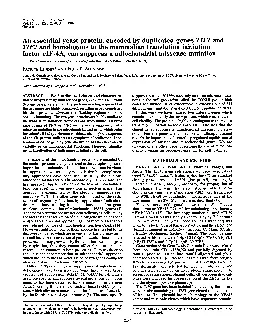

ProcNatlAcadSciUSA8619892287Table1YeaststrainsusedinthisstudyMitochondrialNameNucleargenotypegenotypeSourceCD11B171950MATaleulNAM61karlrhooRef9CW04MATaade2Ihis31115leu23112trpl1ura31canl100rh ID: 888241
Download Pdf The PPT/PDF document "ProcNatiAcadSciUSAVol86pp22862290April19..." is the property of its rightful owner. Permission is granted to download and print the materials on this web site for personal, non-commercial use only, and to display it on your personal computer provided you do not modify the materials and that you retain all copyright notices contained in the materials. By downloading content from our website, you accept the terms of this agreement.
1 Proc.Nati.Acad.Sci.USAVol.86,pp.2286-229
Proc.Nati.Acad.Sci.USAVol.86,pp.2286-2290,April1989GeneticsAnessentialyeastprotein,encodedbyduplicatedgenesTIFJandTIF2andhomologoustothemammaliantranslationinitiationfactoreIF-4A,cansuppressamitochondrialmissensemutation(Saceharomycescerevisiae/suppression/mitochondria/essendiaduplicatedgenes)PATRICKLINDER*ANDPIOTRP.SLONIMSKICentredeGdndtiqueMoldculaireduCentreNationaldelaRechercheScientifique,LaboratoirepropreassocidAl'UniversitdPierreetMarieCurie,91190Gif-sur-Yvette,FranceCommunicatedbyGiuseppeAttardi,DecemberS,1988ABSTRACTWedescribetheisolationandcharacteriza-tionoftwopreviouslyundescribedgenes,TIFIandTIF2,fromSaccharomycescerevisiae.Theprotein-encodingsequencesofthetwogenesarehighlyconserved,resultingintwocompletelyidenticalproteins,whereastheflankingregionsshownoobvioushomology.ThetwoyeastproteinsarehighlysimilartothetranslationinitiationfactoreIF-4Afrommouse.ElevatedgenedosageofTIF)orTIF2resultsinthesuppressionofamissensemutationinthemitochondrialoxi2gene,whichcodesforsubunitMofcytochrome-coxidase,althoughthesequenceoftheTifproteinindicatesitscytoplasmiclocalization.Inac-tivationofeithergenebygenedisruptionhasnoeffectoncellviabilityoronmitochondrialfunctions.However,simulta-neousinactivationofbothgenesislethaltothecell.suppressor,calledNAM6,actsonlyonthreemissensemuta-tionsintheoxi2gene(alsocalledtheCOXIIIgene,whichcodesforsubunitIIIofcytochromecoxidase)outof315differentmit-mutationsanalyzed(ref.9,unpublisheddata).Inthisworkwehaveisolatedtwodifferentgeneswhichencodeindependentlythesameprotein,whichisessentialforcellviability.TheproteinishighlyhomologoustothemousetranslationinitiationfactoreIF-4A(10).Thefactthattheclonedgenessuppressamitochondrialmissensemutationonlywhenthegenesareclonedonamulticopyplasmidrevealstheimportanceofacarefullyregulatedequilibriumofexpressionofnuclearandmitochondrialgenes.Weareunawareofanyotherreportdescribingtheuseofmitochon-driaasasensorforprocessesessentialforcellviability.Themajorityofthemitochondrialproteinsareencodedbythenucleargenomeandsynthesizedinthecytoplasmpriortoimportintomitochondria.Inadditiontothedirectbiochem-icalapproach,twomutuallynonexclusivebutcomplemen-taryapproacheshavebeenusedtostudythenuclear-mitochondrialinteractionsinSaccharomycescerevisiae.Thefirstapproachhasbeenbasedonthelossofmitochondrialfunctionsresultingfrommutationsinnucleargenes.Thisapproachisexemplifiedbythestudyofnumerouspet-mutations(1,2).Theotherapproachisbasedontheresto-rationofrespiratoryfunctionsbysuppressionofmitochon-drialmutationsresultingfrommutationsinnucleargenes(nuclearaccommodationofmitochondria,NAM,genes)(3).Thatthetwoapproachesarenotcontradictoryisindicatedbythefactthattheinactivationofanucleargenewhichhasbeenisolatedbythesecondapproach(gainoffunction)leadstoaperphenotype,lossofmitochondrialfunction(NAM2)(4).However,untilnownoneoftheseapproacheshasledtothediscoveryofgeneswhichareessentialforbasicprocessesinthecellbecausetheselectionofpet-mutantsisbasedontheprinciplethattheygrowwellbyfermentationanddonotgrowbyrespiration,thustheycannotaffectfunctionsthatareessentialandcommontobothprocesses.Herewedescribethe"nuclearaccommodationofmitochondria"approach,whichhasledtothecharacterizationoftwogenescodingforanessentialnonmitochondrialfunction.Differenttypesofnuclearsuppressorsofmitochondrialdeficiencieshavebeenisolated.Somehaveaverybroadspectrumofsuppression[NAM](5);NAM3(6,7)].Othersaremorespecificandsuppressseveralmutationswithinonegene,ashasbeendescribedforthemutationsinthegeneNAM2,codingforthemitochondrialleucyl-tRNAsynthe-tase,whichalleviatesmutationsinthe"maturase"encodedbythefourthintronofcytochromeb(8).ThemostspecificMATERIALSANDMETHODSBacterialStrains,YeastStrains,Plasmids,Phages,andMedia.TheEscherichiacolistrainsweusedwereJA221(recA-,hsdR-,hsdM+,leuB6,trpE5,lacY-)forstandardcloningproceduresandJM101([lac-proAB],thi-,supE,F'traD36,proAB-,lacIQ-,lacZM15)forpropagationofM13phages.TheyeaststrainsarelistedinTable1.Mito-chondriacarryingtheoxi2mutationV382weretransferredintoW303-lB/50bycytoduction,takingadvantageofthekarlmutationinCD8.Mediawereasdescribed(3).ForconstructionofthegenebankweusedtheE.coli-yeastshuttlevectorYEp13(12)andforsubcloningexperiments,pEMBLYe31(13).ThelowcopynumberplasmidpFL39(ARS-CEN-TRPJ)waskindlygiventousbybyF.Lacroute(Gif-sur-Yvette).TheURA3gene(HindIIIfragment)wasgiventousbyB.Guiard(Gif-sur-Yvette),andtheHIS3gene(BamHIfragmentinCMp169)wasfromC.Mann(Centred'EtudesNucleaires,Saclay,France).Theplasmidscon-structedinthisstudywereYEpPL2(YEp13-TIFJ),YEpPL3(YEp13-TIF2),andYCpPL1(pFL39-TIFI).ConstructionoftheGeneBank.GenomicDNAwasisolatedfromthestrainCD11/1830/50andpartiallydigestedbyBamHIpriortoligationintoBamHI-digestedandphos-phatase-treatedYEp13vector.PlasmidDNAfromroughly104colonieswasusedtotransformthestrainW303-lB/V382.Transformantswereselectedforleucineprototrophyandcolonieswerereplicatedonglycerol-containingmediumtoscreenforrespiration-proficientcells.Glycerol-positivecol-onieswereanalyzedforcosegregationoftheLEU2markerandtheglycerol-positivephenotype.TheTIF2genehasbeenisolatedbyscreeningthelibrarywithaprobecontainingtheTIFJgeneclonedontheplasmidpGB2(14).ThisplasmidhasnohomologytotheYEp13vectorandthusonlycloneswhichhavesequenceshomolo-*Present
2 address:MicrobiologyDepartment,Biozentru
address:MicrobiologyDepartment,Biozentrum,4056Basel,Switzerland.2286Thepublicationcostsofthisarticleweredefrayedinpartbypagechargepayment.Thisarticlemustthereforebeherebymarked"advertisement"inaccordancewith18U.S.C.§1734solelytoindicatethisfact. Proc.Natl.Acad.Sci.USA86(1989)2287Table1.YeaststrainsusedinthisstudyMitochondrialNameNucleargenotypegenotypeSourceCD11/B1719/50MATaleulNAM6-1karlrhooRef.9CW04MATaade2-Ihis3-11,15leu2-3,112trpl-1ura3-1canl-100rho+mit+Ref.11W303-lB/50MATaade2-1his3-11,15leu2-3,112trpl-1ura3-1canl-100rhooR.RothsteinW303-1A/DMATaade2-1his3-11,15leu2-3,112trpl-1ura3-1canl-100rho+mit+R.RothsteinW303-IB/V382MATaade2-1his3-11,15leu2-3,112trpl-1ura3-1canl-100rho'oxi2-(V382)Thiswork,cytoductionofV382mitochondriafromCD8CD8MATaleulkarlrho+oxi2-(V382)Ref.9PL37MATatif2::URA3ade2-1his3-11,15leu2-3,112trpl-Jura3-1rho+mit+Thisworkcanl-100PL38MATatifl::HIS3ade2-1his3-11,15leu2-3,112trpl-Jura3-1rho+mit+Thisworkcan1-100PLD1MATa/MATaTIFI/tifl::HIS3tif2::URA3/TIF2ade2/ade2rho+mit+Thiswork,his3/his3leu2/leu2canl-100/canl-100PL37xPL38PL49MATatifl::HIS3tif2::URA3ade2-1his3-11,15leu2-3,112rho+mit+Thiswork,trpl-lura3-1canl-100[YEpPL2]sporeissuefromPLD1goustoTIFIshouldbefound.RestrictionanalysisandhybridizationofTIF-adjacentsequenceshavebeenusedtodistinguishbetweenclonescarryingTIFJandclonescarryingTIF2.GeneralMethods.Transformationofyeastwasperformedaccordingtothelithiumprocedure(15).RestrictionanalysisandSoutherntransferswerecarriedoutaccordingtostan-dardprocedures(ref.16,pp.104and382).RestrictionenzymeswerepurchasedfromAppligene(Strasbourg,France)andBoehringerMannheim.RESULTSIsolationoftheGenesTIF1andTIF2.Usingagenebank,constructedonamulticopyvector,wehaveisolatedaplasmidwhichconferredaglycerol-positivephenotypetothestrainW303-lB/V382,whichnormallycannotgrowonglyc-erolmediumduetoitsmutationintheoxi2gene.Theglycerol-positivephenotypecosegregatedwiththeplasmid-encodedLEU2marker,indicatingclearlythatwehaveinfactclonedagenewhichhassuppressoractivity.Thesuppressoractivityisweakbutclearlyvisibleafter5-8daysofincuba-tionat28°C(Fig.1).WedesignatetheresultingplasmidYEpPL2,andthegenecarriedbytheinsertwedesignateTIFJ(seealsobelow).RestrictionanalysisoftheinsertinplasmidYEpPL2isshowninFig.2.Asubcloneconferringsuppressoractivityisdesignatedsup'Ive.Southernhybridizationexperimentsandgeneticresults(seebelow)suggestedthattherearetwocopiesofthatgenepresentinthegenomeofS.cerevisiae.Wethusisolatedthesecondfragmentfromthesamegenebanktoestablishdifferences(ifany)intheirprimarystructuresandfunctions(i.e.,suppressionoftheoxi2mutationV382).SinceTIFIwasisolatedasasuppressorforamitochondrialmutationwecarriedoutthesameanalysisfortheTIFI-relatedsequence.AsisshowninFig.1,thisclonealsohassuppressoractivityontheoxi2mutationV382.ThisgenethushasanactivitysimilaroridenticaltothatofTIFI.WedesignatethissecondgeneTIF2(seebelow).Gene-Dosage-DependentSuppression.Apriorithesuppres-sioncouldbeduetoagenedosageeffect.WethereforeclonedthegenomicBamHIfragmentencodingTIFIontoalowcopynumberARS-CENplasmid(pFL39).Whenthisplasmid,YCpPL1(pFL39-TIFI),wasintroducedintostrainW303-lB/V382,nogrowthonglycerolcouldbeobservedevenafterprolongedincubation.Thegeneissituatedsuchthatintheclonedfragmentthereisatleast4kbupstreamofthegeneintheBamHIfragment,andsolackofpartofthegeneordistantregulatorysequencescanbeexcluded.ThusweareconvincedthatthesuppressoractivityissolelyduetothefactthatthegenesTIFJandTIF2arepresentatahighgenedosage.OneortheOtherTIFGeneMustBeActiveforCellViability.Sincethegenewasisolatedasasuppressorofamitochon-drialmutationwecarriedoutagenedisruptionofTIFItoseewhetherinactivationofTIFIleadstoaglycerol-negative(i.e.,respiration-deficient)phenotypeorwhetherthegeneisessential.ThegenedisruptionwasmadebyinsertionofaHIS3markerintotheHindIIIsite(Fig.2B).Upontransfor-mationofthehaploidstrainCW04withalinearEcoRV-EcoRIfragment,weisolatedseveralclonesprototrophicforhistidine(His').Sincethedisruptionwassuccessfulinahaploidstraintheinactivationisnotlethal.Thisclone(PL38)didnothavearespiratory-deficientphenotype,aswouldbeexpectedfortheinactivationofageneimplicatedinmito-chondrialfunctions.Aswehavealreadyshown,asecondgene(TIF2)withsimilaroridenticalfunctionsispresentinS.TIF1TIF2TIF2vectorvectorTIF1FIG.1.Respiratorygrowthonglycerolofastraincarryingamissensemutationintheoxi2mitochondrialgene(W303-lB/V382)inpresenceandabsenceoftheTlFgeneonamulticopyplasmid.ThestrainW303-1B/V382wastransformedwithYEp13(vector),YEpPL2(TIFI),orYEpPL3(TIF2)andcolonieswerestreakedonminimalmediumselectivefortheplasmidandcontaining2%glucosepriortoreplicaplatingoncompleteglycerol-containingplates.Theglycerolplateswereincubated8daysat28°C.Twoexamplesofeachtypeoftransformantareshown.Genetics:LinderandSlonimski 2288Genetics:LinderandSlonimskisupinactivezP4lsupacivwe1--1-l-l-141-1141~~~~Q-.asIITIFIII11111,1~~'.,TIF2URA3my��aNeLl!4IIIII~~~~--CImqca04CO)C.v0MA3:IL0.IL~~~~~~.1234TIF2%...TIF1...-.N-I--w'IZ!.4..40_0;CS6789911112_-_-_1kbTIFJBglIIHIS3FIG.2.Localizationandinactivationofthesuppressorfunction.(A)RestrictionmapsoftheBamHIfragmentscarryingTIFiandTIF2.Onlytherelevantrestrictionsitesareshown.Theactivitysuppressingmitochondrialmissensemutations,asshowninFig.1,hasbeenlocalize
3 dbysubcloningtotheNsiI-BamHIfragmentindi
dbysubcloningtotheNsiI-BamHIfragmentindicatedbysupactive.ThelocationsoftheTIFgenesasdeducedfromthesequenceanalysisareindicatedbythearrows.NotethatinTIF2theKpnIsitewithinthegeneisabsentduetoabasesubstitution.(B)InsertionsoftheURA3orHIS3genesintotheHindIIIsites.InthecaseoftheHIS3insertiontheHindIIIsitehadfirstbeenchangedinaBglIIsitebyadditionofalinker.BothinsertionsweremadeinTIFI,andtheKpnI-ClaIfragment(tifl::URA3)andtheEcoRI-EcoRVfragment(tif2::HIS3)wereusedfortheinactivationbyreplacementoftheresidentchromosomalgenesTIF2andTIF)(seetext).kb,Kilobase.cerevisiae.ThiscouldeasilyexplaintheabsenceofanydetectablephenotypeuponinactivationofTIFL.TobecertainthatTIFJinactivationwascompensatedbyTIF2activitywesetouttodisruptthesecondsequenceaswell.TodosoweinsertedintotheHindIIIsiteofTIFJtheURA3geneencodedbyaHindIIIfragment(Fig.2).ThehaploidstrainW303-1A/DwastransformedwithalinearKpnI-ClaIfragmentcarryingtheURA3geneinsertedwithinTIFL.ThisfragmentderivedfromTIFfhasasequencepracticallyidenticaltothatofTIF2(datanotshown),andreplacementofTIF2aswellasreplacementofTIFfcanbeexpected.Indeed,wefoundreplacementofoneortheothergene,butneverboth(seeFig.3,lane3).Growthofthestraintij2::URA3(PL37)onglycerolwasperfectlynormal,aswefoundforthestraincarryingthedisruptedTIFfgene(datanotshown).Disruptionofeithergenegavenomutantphenotype,indicatingthatthetwogenesareisofunctional.Butwhathappenswhenbothgenesaredisruptedinahaploidstrain?Toanswerthisquestionadiploid(PLD1)carryingthetwodisruptedgenestifl::HIS3andtif2::URA3aswellasonewild-typecopyofeachTIFgene(MATa/MATa,TIFftfl::HIS3,tif2::URA3/TIF2;Fig.3,lane4)wascon-structed.Sincethetwogenesarelocatedontwochromo-FIG.3.SouthernblothybridizationofgenomicDNAdigestedwithBamHIandusingTIF)asprobe(2.1-kbNsiI-BamHIfragment,Fig.2).(A)TheparentalstrainW303-1A,thetwostrainshavingoneoftheTIFgenesdisrupted(PL38andPL37),andthediploidstrain(PLD1)havingthetwogenesdisruptedareshownfromlefttoright.(B)Twoexamplesfromthetetradanalysis.Intheparentalditypeallfoursporesareviableandcorrespondeithertooneparent(spores5and7=parent3)ortheother(spores6and8=parent2).Inthetetratypeonesporeismissing,sinceitis,aspredicted,alethal(spore11=parent3,spore10=parent2,spore9=wildtype1).(C)StrainPL49,havingbothgenesdisruptedandcarryingtheplasmidYEpPL2.InAandBtheprobewasapUC13plasmidcarryingtheTIFJgene;inCtheprobewaspGB2-TIF1.DuetothehighcopynumberoftheplasmidYEpPL2,thebandcorrespondingtotheplasmid-encodedTIFismuchstronger.somes(datanotshown),wewouldexpectthatintetradanalysis25%ofthesporesarewild-type(His',Ura')recombinantsifsuchsporescangerminateandleadtotheformationofviablehaploidclones.Nosuchspore,however,couldbeisolatedin32tetradsanalyzed.Thereciprocalrecombinantspores(Ura,His-)werefound16times,indicatingthat,inprinciple,recombinantsporescouldbeobserved.Moreover,inalltetratypetetradsthatissuedfromdiploidsheterozygousforbothgenes,onlythreeviablesporescouldbefound:twooftheparentaltypeandoneofthewildtype,andneverthesporecarryingthetwodisruptedgenes(Fig.3).Theresultssuggestbutdonotprovethateitherofthegeneshastobeactiveforviabilityofthecell.TheproofisgivenbythefactthatsuchsporescouldbeisolatedwhenaplasmidprovidingtheTIFJfunction(YEpPL2)wasintroducedintothediploidpriortosporulation.Insuchananalysissporescarryingthetwodisruptedgenescouldbeisolated(14sporesin27tetrads)andallthecellshavingbothgenesdisruptedcarriedYEpPL2(Fig.3C).Asexpected,nosegregationoftheplasmidinsuchcellscouldbeobservedinnonselectivemedium,perfectlyinagreementwiththeideathatoneoftheTIFgenesmustbeactive.TobesurethattheplasmidYEpPL2wasnotintegratedinthegenome,onesuchclonewastransformedwiththeYCpPL1plasmid(pFL39-TIFI),andsegregationoftheresidentplasmidYEpPL2couldbeAProc.Natl.Acad.Sci.USA86(1989)E Proc.Natl.Acad.Sci.USA86(1989)22891.MSEGITDIEESQIQTNYDKVVYKFDDMELDENLLRGVFGY1MSASQDSRSRDNGPDGMEPEGVIESNWNEIVDSFDDMNLSESLLRGIYAY41GFEEPSAIQQRAIMPIIEGHDVLAQAQSGTGKTGTFSIAALQRIDTSVKA111III1I1111:111I1:1111111111:11I11::1151GFEKPSAIQQRAILPCIKGYDVIAQAQSGTGKTATFAISILQQIELDLKA91PQALMLAPTRELALQIQKVVMALAFHMDIKVHACIGGTSFVEDAEGLR..101TQALVLAPTRELAQQIQKVVPIALGDYMGASCHACIGGTNVRAEVQKLQME139151DAQIVVGTPGRVFDNIQRRRFRTDKIKMFILDEADEMLSSGFKEQIYQIF':1:111111111::II:1111:111111111111:111:11APHIIVGTPGRVFDMLNRRYLSPKYIKMFVLDEADEMLSRGFKDQIYDIF189TbLPPTTQVVLLSATMPNDVLEVTTKFMRNPVRILVRKDELTLEGIKQFY201QKLNSNTQVVLLSATMPSDVLEVTKKFMRDPIRILVKKEELTLEGIRQFY239VNVEEEEYKYECLTDLYDSISVTQAVIFCNTRRKVEELTTKLRNDKFTVS251INVEREEWKLDTLCDLYETLTITQAVIFINTRRKVDWLTEKMHARDFTVS289AIYSDLPQQERDTIMKEFRSGSSRILISTDLLARGIDVQQVSLVINYDLP1::'1::1111:111111111111301AMHGDMDQKERDVIMREFRSGSSRVLITTDLLARGIDVQQVSLVINYDLP339ANKENYIHRIGRGGRFGRKGVAINFVTNEDVGAMRELEKFYSTQIEELPS351TNRENYIHRIGRGGRFGRKGVAINMVTEEDKRTLRDIETFYNTSIEEMPL389DIATLLN401NVADLI.FIG.4.ComparisonoftheproteinsequenceoftheyeastTifproteinwiththemouseeIF-4Aprotein(10,18).TheyeastTifproteinisshownontheupperline,andeIF-4Aisshownonthelowerline.Identicalaminoacidsareindicatedbyverticalbars,andaminoacidsthataresimilaraccordingtotherulesofDayhoff(17)areindicatedbydotsbetweenthesequences.observed.ItisthusclearthateithertheTIF1ortheTIF2genehastobeactivetoensurethesurvivalofthecell.TheTifProteinIsHighlyHomologoustoeIF-4AfromMouse.WealsoestablishedtheprimarysequenceofthegenesTIFIandTIF2.The
4 sequence(datanotshown;EMBLdatabankaccess
sequence(datanotshown;EMBLdatabankaccessionnumbersX12813andX12814)revealsanopenreadingframefor395aminoacids(seeFig.4).Inter-estingly,theproteinsencodedbythetwogenesarecom-pletelyidentical,whereastheflankingsequencessharenoobvioushomology.Withinthecodingregiononly5basesubstitutionsin1185nucleotidesarefound.WehavesearchedinadatabankforhomologiesoftheTifproteinwithotherknownproteinsandfoundaremarkablehomologytotheproteineIF-4A(eukaryotictranslationinitiationfactor)frommouse(10).Outofthe395aminoacidresiduesfromtheyeastprotein,257areidenticaltotheresiduesinthemouseprotein(65%identity)and62aresimilaraccordingtotherulesofDayhoff(17),whichbringsthetotalto81%identity+similarity.Inadditiontosharingthisextendedhomologythetwoproteinshaveasimilarsize,onlyaminorgapoccurringintheyeastprotein.Thehomol-ogyisdistributedovertheentireprotein(Fig.4).WearethusconvincedthatthetwogeneswehaveclonedcodefortheyeastanalogueoftheeIF-4Aproteinfrommouse.DISCUSSIONWedescribeheretheisolationandbasiccharacterizationoftwopreviouslyunreportedgenesfromS.cerevisiae,TIF1andTIF2.Inactivationbyreplacementofeithergenegivesnoobviousphenotype,butdeletionofbothislethaltothecell,indicatingthatthetwogenesareisofunctionalandthatnei-therofthemrepresentsapseudogene.ThetwogenesTIFIandTIF2haveanopenreadingframeof395codons.Thetwoproteinsarecompletelyidentical,whereastheflankingsequencesaredifferent.ComparisonoftheproteinsequencewithsequencesindatabanksrevealedanextensivehomologywiththemousetranslationinitiationfactoreIF4A(10).Althoughwehavenofunctionalproofoftheidentityoftheseproteins,itisunlikelythattheproteinsencodedbytheTIFgenesdonotcodeforthesamefunctioninS.cerevisiae.Thehomologyisextremelyhigh(65%identicaland81%identical+similaraminoacids)andisdistributedthroughoutthecodingregion.Thereexistsonlyaminorgapoftwoaminoacidsintheyeastproteinwithrespecttothemouseprotein,andthetwoproteinshavealmostthesamesize.Itisinterestingtonotethatalsoinmousetwogenesarefound,whichcodefortwoeIF-4Aproteinsthathave98%conservedaminoacids(18).TheconservationoftheproteinsequencefrombuddingyeasttomouseisremarkableinthecaseofeIF-4A.AnotherhighlyconservedproteinistheelongationfactorTEF[yeastcomparedwithArtemiasalina(19)].Theelongationfactorisconserved80%alongtheentireproteinand,asforTIFJandTIF2,thetwogenesoftheelongationfactorinyeastcodefortwocompletelyidenticalproteins.Recentlytheisolationandcharacterizationoftheyeastcap-bindingprotein(eIF-4E)fromS.cerevisiaehavebeendescribed(20).AtleastinmammaliancellstheeIF-4Eproteinisfoundinacomplex(eIF-4F)whichalsocontainseIF-4A(21).TheeIF-4Fcomplex,whichcontainsthecap-bindingprotein,a220-kDaprotein,andeIF-4A,isinvolvedintheassemblyofthemRNAandthe43Spreinitiationcomplex(forreviewseeref.22).Uptonowmostoftheknowledgeoneukaryotictranslationinitiationcomesfrominvitroexperimentsusingcellextractsandpurifiedfactorsfromdifferentsources.Onlyafewgeneticdatarelevanttothebiochemicalresultsontheinitiationprocessareavailable.TheisolationofthegenescodingforeIF-4AandeIF-4EfromS.cerevisiaeopensthewaytoageneticanalysisofthetranslationinitiationprocess.WithoutextensivebiochemicalanalysisitisnotpossibletodefinitelysaywhethertheTifproteinisreallyatranslationinitiationfactor.Thereare,however,anumberofgoodargumentsforthis,andthepicturewhichhasemergedfortheTIFgenesisreminiscentofothergenesinvolvedintransla-tion.(i)Therearetwocopiesofthegene,whichcodefortwoabsolutelyidenticalproteins.Suchsituationshavebeenfoundformanyotherproteinsinvolvedintranslation(19,23,24).(ii)Thetwogenesseemtobehighlyexpressed,asjudgedbothfromthemRNAhybridizationandfromthehighlybiasedcodonusage(datanotshown;refs.25and26).(iii)Inthe5'regionoftheTIFfgenetherearealsotwosequences(AACTTCCAGGCACATandAACATCCGATGCTTGat-367and-239withrespecttotheATG)whichresembletheUASrpg,TACTGGATTTAGACAACCCA'apromoterelementoftenfoundinribosomalproteingenes(27).ThegeneTIFJhasbeenisolatedasasuppressorgeneforamissensemutationinthemitochondrialoxi2gene(subunitIIIofcytochrome-coxidase).ByhomologywehavealsoisolateditstwinTIF2,whichisisofunctionaltoTIFIwithrespecttocellviabilityandsuppressionofthemitochondrialmutationV382.Suppressioncanbeobservedonlywhenthegenesareclonedonahighcopynumberplasmid,whichagainrevealstheimportanceofanequilibratedexpressionofnuclearandmitochondrialgenesformitochondrialfunctions.Ithasalreadybeenshownthatnuclearsuppressionofmit-mutationsgreatlydependsonthecopynumberoftheclonedgene(8,28-30).Itisnotclear,however,howacytoplasmictranslationinitiationfactorcouldsuppressmissensemutationsinaGenetics:LinderandSlonimski 2290Genetics:LinderandSlonimskimitochondrialgene.AsjudgedfromtheDNAsequence,theproteinisunlikelytobetargetedtothemitochondria.Nostrictrulehasbeenfoundformitochondrialtargetingse-quences(31),andsowecannotexcludethattheproteinisimportedintomitochondria.Insomecasestwoalternativeinitiationcodonshavebeenfound,oneforacytoplasmicallylocatedproteinandtheotherforamitochondriallylocatedprotein(32).ButinthecaseoftheTIFgenes,neitherup-nordownstreamcouldwefindalikelycandidateforsuchanalternativeinitiationcodon.Fromtheabsenceofaconsensusintronsequence[TACTAAC(33)]andtheabsenceofanappropriatereadingframe5'totheATGinitiationcodonwecanalsoexcludethepresenceofanintron,ashasbeenobservedformanyribosomalpr
5 oteingenes(34).Further-more,themitochond
oteingenes(34).Further-more,themitochondrialtranslationmachineryisquitedif-ferentfromthecytoplasmicone,andsotheimplicationofacytoplasmicfactorinsuppressionofamitochondrialmuta-tionisdifficulttoexplain.Itis,however,possiblethattheTifproteinhasanadditionalfunctioninthecellwhichisnotyetknownandthatthisfunctionisresponsibleforthesuppres-sionoftheoxi2mutation.DualfunctionshaverecentlybeenreportedformitochondrialtRNAsynthetases(8,35).AstheTifproteinisexpectedtobeabundantinthecytoplasm,itwillbedifficulttoproveunambiguouslyamitochondriallocal-izationevenbycellfractionationandantibodies.ThegeneticanalysisoftheTIFgenesshouldbeabletoanswerthisquestion.Atpresent,however,wefavorahypothesisofindirectsuppression.ItisknownfrombiochemicalanalysisthatthemammalianeIF-4Aproteinisinvolvedinunwindingandselectionofthe5'regionofthemRNA(36,37).ItisthuspossiblethatundernormalconditionstheinitiationfactoreIF-4AislimitingandthatnotallmRNAsaretranslatedefficiently.Inourcasethiswouldimplythat,incellsinwhichtheTIFgenesarepresentatahighcopynumber,anincreasedquantityofTifproteinisavailableandmRNAsthatundernormalconditionsarepoorlytranslatedbecomemoreeffi-cientlytranslated.Suchagenecouldcodeforacytoplasmi-callytranslated,mitochondriallylocatedprotein.So,incellshavingahighTIFcopynumber,thismitochondrialproteinwouldbemoreabundantandleadtosuppressionofthemitochondrialmissensemutation.NoteAddedinProof.(i)AthirdClaIsiteispresent3'tothegeneTIFJ.(ii)TheTifproteinbelongstoalargefamilyofnucleicacidunwindingproteinscharacterizedbytheDEADbox(38).WethankJ.Banroques-Blot,A.Gargouri,A.Kruszewska,andJ.Lazowskaforhelpfuldiscussionsandfriendlycollaboration;C.Mann,B.Guiard,andF.Lacrouteforstrainsandplasmids;andJ.Renowickiforhelpincomputeranalysis.P.L.acknowledgesthereceiptoffellowshipsfromtheFondsNationalSuissedelaRecher-cheScientifiqueandtheEuropeanMolecularBiologyOrganization.ThisworkwassupportedbygrantsfromtheCentreNationaldelaRechercheScientifique,ActionThdmatiqueProgrameeBiologieMol6culaireduGene,theInstitutNationaldelaSanteetdelaRechercheMedicale,laLigueNationaleFrangaisecontreleCancer(toP.P.S.),and,inthefinalstage,byGrant3.568-0.87fromtheFondsNationalSuisse(toP.L.).1.Sherman,F.&Slonimski,P.P.(1964)Biochim.Biophys.Acta90,1-15.2.Tzagoloff,A.&Myers,A.M.(1986)Annu.Rev.Biochem.55,249-285.3.Dujardin,G.,Pajot,P.,Groudinsky,0.&Slonimski,P.P.(1980)Mol.Gen.Genet.179,469-482.4.Labouesse,M.,Dujardin,G.&Slonimski,P.P.(1985)Cell41,133-143.5.Groudinski,O.,Dujardin,G.&Slonimski,P.P.(1981)Mol.Gen.Genet.184,493-503.6.Kruszewska,A.&Slonimski,P.P.(1984)Curr.Genet.9,1-10.7.Kruszewska,A.&Slonimski,P.P.(1984)Curr.Genet.9,11-19.8.Herbert,C.J.,Labouesse,M.,Dujardin,G.&Slonimski,P.P.(1988)EMBOJ.7,473-483.9.Kruszewska,A.&Szczesniak,B.(1985)Curr.Genet.10,87-93.10.Nielsen,P.J.,McMaster,G.K.&Trachsel,H.(1985)NucleicAcidsRes.13,6867-6880.11.Banroques,J.,Delahodde,A.&Jacq,C.(1986)Cell46,837-844.12.Broach,J.R.,Strathern,J.N.&Hicks,J.B.(1979)Gene8,121-133.13.Baldari,C.&Cesareni,G.(1985)Gene35,27-32.14.Churchward,G.,Belin,D.&Nagamine,Y.(1984)Gene31,165-171.15.Ito,H.,Fukuda,Y.,Murata,K.&Kimura,A.(1983)J.Bacteriol.153,163-168.16.Maniatis,T.,Fritsch,E.F.&Sambrook,J.(1982)MolecularCloning:ALaboratoryManual(ColdSpringHarborLab.,ColdSpringHarbor,NY).17.Dayhoff,M.O.,Schwartz,R.M.&Oncutt,B.C.(1978)inAtlasofProteinSequenceandStructure,ed.Dayhoff,M.0.(Natl.Biomed.Res.Found.,SilverSpring,MD),Vol.5,Suppl.3,pp.345-352.18.Nielsen,P.J.&Trachsel,H.(1988)EMBOJ.7,2097-2105.19.Schirmaier,F.&Philippsen,P.(1984)EMBOJ.3,3311-3315.20.Altmann,M.,Handschin,C.&Trachsel,H.(1987)Mol.Cell.Biol.7,998-1003.21.Edery,I.,Humbelin,M.,Darveau,A.,Lee,K.A.W.,Mil-burn,S.,Hershey,J.W.B.,Trachsel,H.&Sonenberg,N.(1983)J.Biol.Chem.258,11398-11403.22.Pain,V.M.(1986)Biochem.J.235,625-637.23.Abovich,N.&Rosbash,M.(1984)Mol.Cell.Biol.4,1871-1882.24.Molenaar,C.M.T.,Woudt,L.P.,Jansen,A.E.M.,Mager,W.H.&Planta,R.J.(1984)NucleicAcidsRes.12,7345-7358.25.Bennetzen,J.L.&Hall,B.D.(1982)J.Biol.Chem.257,3026-3031.26.Hoekema,A.,Kastelein,R.A.,Vasser,M.&deBoer,H.A.(1987)Mol.Cell.Biol.7,2914-2924.27.Lambertus,P.W.,Mager,W.H.,Nieuwint,R.T.M.,Was-senaar,G.M.,vanderKuyl,A.C.,Murre,J.J.,Hockman,M.F.M.,Brockhoff,P.G.M.&Planta,R.J.(1987)NucleicAcidsRes.15,6037-6048.28.Labouesse,M.,Herbert,C.J.,Dujardin,G.&Slonimski,P.P.(1987)EMBOJ.6,713-721.29.Koll,H.,Schmidt,C.,Wiesenberger,G.&Schmelzer,C.(1987)Curr.Genet.12,503-509.30.Schmidt,C.,Sollner,T.&Schweyen,R.J.(1987)Mol.Gen.Genet.210,145-152.31.vanHeijne,G.(1986)EMBOJ.5,1335-1342.32.Natsoulis,G.,Hilger,F.&Fink,G.R.(1986)Cell46,235-243.33.Teem,L.J.,Abovich,N.,Kaufer,N.F.,Schwindinger,W.F.,Warner,J.R.,Levy,A.,Woolfort,J.,Leer,R.J.,Raamsonk-Duin,M.M.C.,Mager,W.H.,Planta,R.J.,Schultz,L.,Friesen,J.D.,Fried,H.&Rosbach,M.(1984)NucleicAcidsRes.12,8295-8312.34.Fink,R.G.(1987)Cell49,5-6.35.Akins,R.A.&Lambowitz,A.M.(1987)Cell50,331-345.36.Ray,B.K.,Brendler,T.G.,Adya,S.,Daniels-McQueen,S.,Miller,J.K.,Hershey,J.W.B.,Grifo,J.A.,Merrick,W.C.&Thach,R.E.(1983)Proc.Natl.Acad.Sci.USA80,663-667.37.Panniers,R.,Stewart,E.B.,Merrick,W.C.&Henshaw,E.C.(1985)J.Biol.Chem.260,9648-9653.38.Linder,P.,Lasko,P.F.,Ashburner,M.,Leroy,P.,Nishi,K.,Schnier,J.&Slonimski,P.P.(1989)Nature(London)337,121-122.Proc.Natl.Acad.Sci.USA86(198